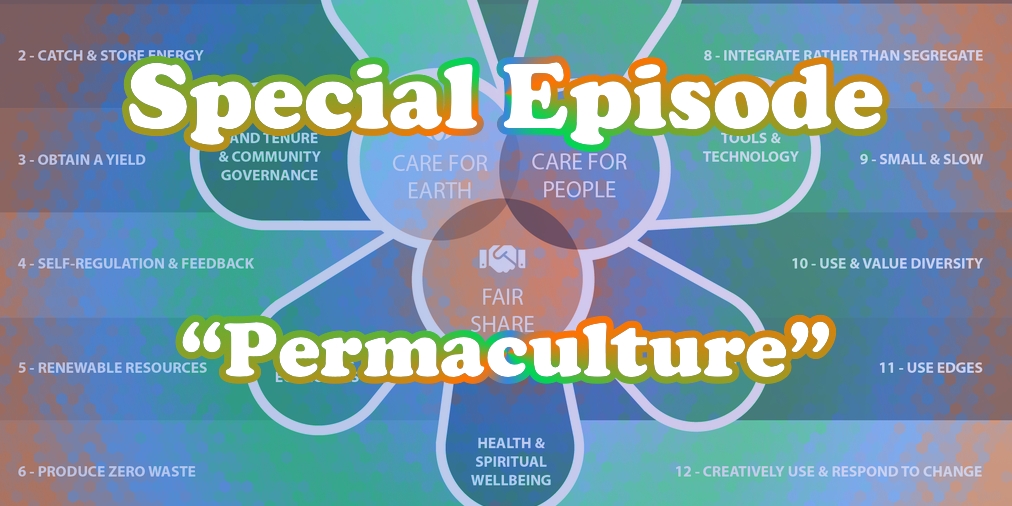I Have No Idea What I'm Doing
-

- Hosted by Andrew Huster and Aaron LM Goodwin
Join us on a wondrous journey through whatever’s on our minds this week. We have no idea what we’re doing. But we’re trying.
Thinking about the three ethics.
Our Goodstuff Patreon Subscribers and listeners just like you! Support your favorite podcasts directly to get exclusive unedited episodes and more.

- Scope of this episode
- I want to explain the value of permaculture
- I will try to avoid jargon
- It can be alienating
- Also, I am dummy and have lots to learn
- What is Permaculture?
- Permaculture is hard to define
- Permaculture, as an idea, is sprawling and all-encompassing. It can be difficult to easily define because it is almost like a whole ideology or culture.
- It is a system
- The thing about it is, it’s not sectarian
- This is why you’re just as likely to find it practiced by anarchists or free market chuds
- Though there are prominent and foundational figures, there’s no czar of permaculture and there’s no codified creed.
- The thing about it is, it’s not sectarian
- There is a “founder”, but it sort of acretes concepts and practices like a sort of katamari damacy
- Perhaps the best way to define it is to begin by explaining its origins.
- Origins
- What is it’s root? Where did it come from and why was it created?
- Tasmania, 1978
- The term permaculture was coined by David Holmgren, then a graduate student at the Tasmanian College of Advanced Education’s Department of Environmental Design, and Bill Mollison, senior lecturer in Environmental Psychology at University of Tasmania, in 1978.
- 1979–1983 Eastern Australian drought - Wikipedia
- Ethics, Principles Methods, Developments
- Ethics
- The Three Ethics
- Earth Care: Provision for all life systems to continue and multiply.
- People Care: Provision for people to access those resources necessary for their existence
- Fair Share (Setting limits to population and consumption): By governing our own needs, we can set resources aside to further the above principles.
- The Three Ethics
- Principles
- Observe and interact: By taking time to engage with nature we can design solutions that suit our particular situation.
- Catch and store energy: By developing systems that collect resources at peak abundance, we can use them in times of need.
- Obtain a yield: Ensure that you are getting truly useful rewards as part of the work that you are doing.
- Apply self-regulation and accept feedback: We need to discourage inappropriate activity to ensure that systems can continue to function well.
- Use and value renewable resources and services: Make the best use of nature’s abundance to reduce our consumptive behavior and dependence on non-renewable resources.
- Produce no waste: By valuing and making use of all the resources that are available to us, nothing goes to waste.
- Design from patterns to details: By stepping back, we can observe patterns in nature and society. These can form the backbone of our designs, with the details filled in as we go.
- Integrate rather than segregate: By putting the right things in the right place, relationships develop between those things and they work together to support each other.
- Use small and slow solutions: Small and slow systems are easier to maintain than big ones, making better use of local resources and producing more sustainable outcomes.
- Use and value diversity: Diversity reduces vulnerability to a variety of threats and takes advantage of the unique nature of the environment in which it resides.
- Use edges and value the marginal: The interface between things is where the most interesting events take place. These are often the most valuable, diverse and productive elements in the system.
- Creatively use and respond to change: We can have a positive impact on inevitable change by carefully observing, and then intervening at the right time.
- Methods
- Food forests
- Water capture and storage
- Contoured earthworks AKA Swales
- Check Dams
- Greenhouses
- Rotational grazing
- Composting systems
- Urban food production
- Grey water use
- Aquaculture
- Renewable energy and heat
- Natural building
- Rammed earth, Adobe, etc.
- Earth ships
- Ethics
- Permaculture is hard to define
- Why is it important?
- Water loss
- Runoff
- Pumping more ground water than is absorbed
- Floods
- Soil loss and fertility
-
Traditional agriculture treats topsoil as a consumable resource
Every second, North America’s largest river carries another dump truck’s load of topsoil to the Caribbean. Each year, America’s farms shed enough soil to fill a pickup truck for every family in the country. This is a phenomenal amount of dirt. But the United States is not the biggest waster of this critical ical resource. An estimated twenty-four billion tons of soil are lost annually ally around the world-several tons for each person on the planet. Despite such global losses, soil erodes slowly enough to go largely unnoticed in anyone’s lifetime. (David R. Montgomery. Dirt: The Erosion of Civilizations (Kindle Locations 61-64). Kindle Edition.)
-
It takes time to naturally build topsoil
The United States Department partment of Agriculture estimates that it takes five hundred years to produce duce an inch of topsoil. Darwin thought English worms did a little better, making an inch of topsoil in a century or two. While soil formation rates vary in different regions, accelerated soil erosion can remove many centuries turies of accumulated soil in less than a decade. Earth’s thin soil mantle is essential to the health of life on this planet, yet we are gradually stripping it off-literally skinning our planet. (David R. Montgomery. Dirt: The Erosion of Civilizations (Kindle Locations 296-298). Kindle Edition.)
-
Example: Rome
-
Rome had flourishing agriculture that fed the city, but soil-loss and fertility loss became a major factor in the ‘fall of rome’
In 1916 Columbia University professor Vladimir Simkhovitch argued that lack of dirt caused the decline of the Roman Empire. Soil exhaustion and erosion had depopulated the Roman countryside in the empire’s late days; he pointed out that the amount of land needed to support a Roman farmer had increased from the small allotment given to each citizen at the founding of Rome to ten times as much land by the time of Julius Caesar. (David R. Montgomery. Dirt: The Erosion of Civilizations (Kindle Locations 794-797). Kindle Edition.)
- The economics of empire pushed for more and more slave-labor high-value crops
- This lead to worse and worse agricultural practices with tremendous erosion
- Rome relied more and more on expanding their empire and turning formerly mixed-use land into intensive cereal or olive production
- Much of the desertification of Northern Africa can be attributed to Roman imperial agriculture
-
-
- Inevitable contraction of globalism
- Carbon sequestration
- Resilient and diverse food systems
- Regenerative
- Water loss
- What are examples of it in practice?
- Zaytuna Farms
- Polyface Farms
- Greening The Desert Project: Jordan
- Al Bayda
- Brad Lancaster
- New Forest Farm
- What comes next?
- Shortcomings and issues
- It takes more human labor
- Gee, if only we had a mass of people without jobs who would find this work rewarding and enriching…
- Once again: capitalism
- It doesn’t scale and isn’t as profitable under the economic and social system as it is
- It isn’t a capital-based system
- It takes more human labor
- Reading/Viewing/resources
-
[Gaia’s Garden by Toby Hemenway Chelsea Green Publishing](https://www.chelseagreen.com/product/gaias-garden/) - @BuildSoil - Twitter
- One Community - Open-source Permaculture
- Hope in a Changing Climate - by John D. Liu (2009) - YouTube
- The Paradigm Shift leading to Survival and Sustainability - John D. Liu - TEDxWageningenUniversity - YouTube
-
- Individual Experimentation
- Get involved with local permaculture
- Shortcomings and issues